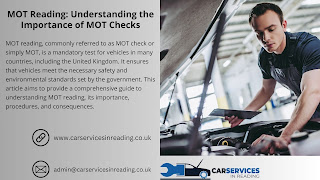MOT reading, commonly referred to as MOT check
or simply MOT, is a mandatory test for vehicles in many countries, including
the United Kingdom. It ensures that vehicles meet the necessary safety and
environmental standards set by the government. This article aims to provide a
comprehensive guide to understanding MOT reading, its importance, procedures,
and consequences.
Importance of MOT Checks
MOT checks are crucial for several reasons.
Firstly, they ensure that vehicles on the road meet minimum safety standards,
reducing the risk of accidents and injuries. Additionally, MOT tests help in
controlling vehicle emissions, contributing to environmental protection
efforts. Moreover, having a valid MOT certificate is a legal requirement for
most vehicles, and driving without one can lead to penalties or fines.
Understanding MOT Regulations
MOT regulations outline the specific
criteria that vehicles must meet to pass the test. The test typically includes
various components, each aimed at assessing different aspects of the vehicle's
condition.
MOT Test Components
The MOT test
consists of several key components:
1. Visual Inspection: This includes checking the condition
of essential parts such as lights, brakes, tires, and mirrors.
2. Emissions Test: Vehicles are tested to ensure they
meet the prescribed emission standards, helping to reduce air pollution.
3. Safety Checks: Inspectors assess the overall safety
of the vehicle, including its structural integrity and functionality of safety
features like seatbelts and airbags.
Preparing for MOT
To increase
the chances of passing the MOT test, vehicle owners should undertake regular
maintenance and inspections. A pre-MOT checklist can help identify any potential
issues that need addressing before the test.
What Happens During an MOT Test?
During the
MOT test, certified inspectors examine various aspects of the vehicle to
determine its roadworthiness. This includes testing procedures such as brake
performance, suspension, and exhaust emissions. Common failures include issues
with brakes, lights, and tire tread depth.
After the MOT Test
If a vehicle
fails the MOT test, owners are provided with a list of necessary repairs or
replacements. Once these issues are addressed, the vehicle can undergo a
retest. Renewing the MOT certificate is essential to ensure compliance with
legal requirements.
Benefits of Passing MOT
Passing the
MOT test demonstrates that a vehicle meets the necessary safety and
environmental standards. It provides peace of mind to the owner and ensures
that the vehicle is legally compliant for road use.
Consequences of Failing MOT
Failing the
MOT test can have significant consequences. It may result in the vehicle being
deemed unfit for road use until necessary repairs are made. Additionally,
driving without a valid MOT certificate can lead to fines or penalties imposed
by authorities.

Comments
Post a Comment